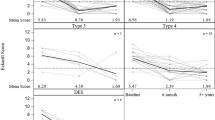Abstract
Background
Optimal treatment for symptomatic patients with non-achalasia motility disorders (NAD) such as diffuse esophageal spasm, esophagogastric junction outlet obstruction, and hypercontractile disorder is not well established. POEM has been offered to these patients since it is a less invasive and less morbid procedure but long-term outcomes remain undetermined. The aim of this study was to assess long-term outcomes of POEM for patients with NAD.
Methods
Records of 40 consecutive patients undergoing POEM for NAD from May 2011 to January 2016 at a single center were retrospectively reviewed. Preoperative and 6-month postoperative symptom scores, high-resolution manometry, pH testing, and timed barium swallow (TBS) data were collected. Patients were contacted by phone to obtain long-term symptom assessment. Symptoms were assessed using a standardized symptom questionnaire with scores for symptoms graded according to frequency and the Eckardt score.
Results
Ten percent had minor complications with no postoperative sequelae. 90% of patients had significant improvement in their mean Eckardt scores (5.02 vs. 1.12, p < 0.001) at early follow-up. Improvements in chest pain (1.02–0.36, p = 0.001) and dysphagia (2.20 vs. 0.40, p = 0.001) were seen. Significant improvements in manometric pressures and esophageal emptying on TBS were observed across groups. 38% (10/26) of patients had a postoperative pH score > 14.72. Long-term (median 48 months) symptom scores were obtained from 29 (72.5%) patients. 82% of patients (24/29) had sustained symptom improvement. A small increase in the dysphagia scores was reported in the long-term follow-up compared to the immediate postoperative period (0.36–0.89, p = 0.046).
Conclusions
Chest pain and dysphagia are effectively palliated with POEM in patients with non-achalasia disorders of the esophagus. Significant improvements are durable in long-term follow-up. Despite earlier reports by our group suggesting possible inferior outcomes from POEM for this difficult group of patients, this study is far more encouraging. POEM should be considered in the treatment of patients with non-achalasia disorders of the esophagus.






Similar content being viewed by others
References
Minami H, Isomoto H, Yamaguchi N et al (2014) Peroral endoscopic myotomy (POEM) for diffuse esophageal spasm. Endoscopy. https://doi.org/10.1055/s-0032-1309922
Khashab M, Messallam AA, Onimaru M et al (2014) International multicenter experience with peroral endoscopic myotomy (POEM) for the treatment of spastic esophageal disorders refractory to medical therapy. Gastrointest Endosc 79(5):AB167–AB167
Bechara R, Ikeda H, Inoue H (2016) Peroral endoscopic myotomy for Jackhammer esophagus: to cut or not to cut the lower esophageal sphincter. Endosc Int Open 4(5):E585–E588. https://doi.org/10.1055/s-0042-105204
Kandulski A, Fuchs KH, Weigt J, Malfertheiner P (2016) Jackhammer esophagus: high-resolution manometry and therapeutic approach using peroral endoscopic myotomy (POEM). Dis Esophagus 29(6):695–696. https://doi.org/10.1111/dote.12182
Kristensen HO, Bjerregaard NC, Rask P, Mortensen FV, Kunda R (2014) Peroral endoscopic myotomy (POEM) for nutcracker esophagus. Three cases with 12 months follow-up. Scand J Gastroenterol 49(11):1285–1289. https://doi.org/10.3109/00365521.2014.958096
Hoppo T, Thakkar SJ, Schumacher LY et al (2016) A utility of peroral endoscopic myotomy (POEM) across the spectrum of esophageal motility disorders. Surg Endosc Other Interv Tech 30(1):233–244. https://doi.org/10.1007/s00464-015-4193-y
Eckardt VF, Aignherr C, Bernhard G (1992) Predictors of outcome in patients with achalasia treated by pneumatic dilation. Gastroenterology 103(6):1732–1738. https://doi.org/10.1053/j.gastro.2008.07.022.Achalasia
Kahrilas PJ, Bredenoord AJ, Fox M et al (2015) The Chicago classification of esophageal motility disorders, v3.0. Neurogastroenterol Motil 27(2):160–174. https://doi.org/10.1111/nmo.12477
Sharata AM, Dunst CM, Pescarus R et al (2014) Peroral endoscopic myotomy (POEM) for esophageal primary motility disorders: analysis of 100 consecutive patients. J Gastrointest Surg 19(1):161–170. https://doi.org/10.1007/s11605-014-2610-5
Sharata A, Kurian AA, Dunst CM, Bhayani NH, Reavis KM, Swanstrom LL (2014) Technique of per-oral endoscopic myotomy (POEM) of the esophagus (with video). Surg Endosc Other Interv Tech 28(4):1333. https://doi.org/10.1007/s00464-013-3332-6
Ford AC, Suares NC, Talley NJ (2011) Meta-analysis: the epidemiology of noncardiac chest pain in the community. Aliment Pharmacol Ther 34(2):172–180. https://doi.org/10.1111/j.1365-2036.2011.04702.x
Richter JE, Bradley LA, Castell DO (1989) Esophageal chest pain: current controversies in pathogenesis, diagnosis, and therapy. Ann Intern Med 110(1):66–78
Fass R, Achem SR (2011) Noncardiac chest pain: epidemiology, natural course and pathogenesis. J Neurogastroenterol Motil 17(2):110–123. https://doi.org/10.5056/jnm.2011.17.2.110
Achem SR, Kolts BE (1992) Current medical therapy for esophageal motility disorders. Am J Med 92(5A):98S–105S
Patti MG, Pellegrini CA, Arcerito M, Tong J, Mulvihill SJ, Way LW (1995) Comparison of medical and minimally invasive surgical therapy for primary esophageal motility disorders. Arch Surg 130(6):606–609. http://ovidsp.ovid.com/ovidweb.cgi?T=JS&PAGE=reference&D=med3&NEWS=N&AN=7763169
Almansa C, Hinder RA, Smith CD, Achem SR (2008) A comprehensive appraisal of the surgical treatment of diffuse esophageal spasm. J Gastrointest Surg 12(6):1133–1145. https://doi.org/10.1007/s11605-007-0439-x
Khan MA, Kumbhari V, Ngamruengphong S et al (2017) Is POEM the answer for management of spastic esophageal disorders? A systematic review and meta-analysis. Dig Dis Sci 62(1):35–44. https://doi.org/10.1007/s10620-016-4373-1
Salvador R, Costantini M, Rizzetto C, Zaninotto G (2012) Diffuse esophageal spasm: the surgical approach. Dis Esophagus 25(4):311–318. https://doi.org/10.1111/j.1442-2050.2010.01172.x
Moonen A, Annese V, Belmans A et al (2016) Long-term results of the European achalasia trial: a multicentre randomised controlled trial comparing pneumatic dilation versus laparoscopic Heller myotomy. Gut 65(5):732–739. https://doi.org/10.1136/gutjnl-2015-310602
Henderson RD, Ryder D, Marryatt G (1987) Extended esophageal myotomy and short total fundoplication hernia repair in diffuse Esophageal spasm: five-year review in 34 patients. Ann Thorac Surg 43(1):25–31. https://doi.org/10.1016/S0003-4975(10)60161-0
Elus FH (1992) Esophagomyotomy for noncardiac chest pain resulting from diffuse esophageal spasm and related disorders. Am J Med. https://doi.org/10.1016/0002-9343(92)80068-B
Minami H, Inoue H, Haji A et al (2016) PER—oral endoscopic myotomy: emerging indications and evolving techniques. Gastroenterol Endosc 58(7):1259–1266. https://doi.org/10.1111/den.12328
Author information
Authors and Affiliations
Corresponding author
Ethics declarations
Disclosures
Kevin Reavis is a consultant for Boston Scientific, Endogastric Solutions and Stryker. He perceived advisory honoraria from Ethicon, Gore and Apollo. Steven Demeester and Christy M. Dunst are consultants for Bard. Lee Swanstrom is on the Scientific Advisory board of Olympus, Boston Scientific and Apollo. Filippo Filicori, Ahmed Sharata, Walaa F. Abdelmoaty, Ahmed M. Zihni have no conflict of interest or financial ties to disclose.
Rights and permissions
About this article
Cite this article
Filicori, F., Dunst, C.M., Sharata, A. et al. Long-term outcomes following POEM for non-achalasia motility disorders of the esophagus. Surg Endosc 33, 1632–1639 (2019). https://doi.org/10.1007/s00464-018-6438-z
Received:
Accepted:
Published:
Issue Date:
DOI: https://doi.org/10.1007/s00464-018-6438-z




